Artificially obtained fish breeds almost always differ in color from their ancestral forms. This is completely understandable because, in nature, a bright color can cost its owner life, in an aquarium, there are no restrictions. The electric blue Apistogramma is a vivid example of such a modification. We will tell you how to properly keep this magnificent fish in our article.
General information
Apistogramma electric blue (Mikrogeophagus ramirezi var “Electric Blue”) is a selection from the well-known Ramirezi Apistogramma. The key feature of the breed is its unusually bright blue color with a characteristic metallic sheen.
It is one of the most spectacular aquarium fish. And although some find excessive artificiality in its color, the Apistogramma does not lose its popularity.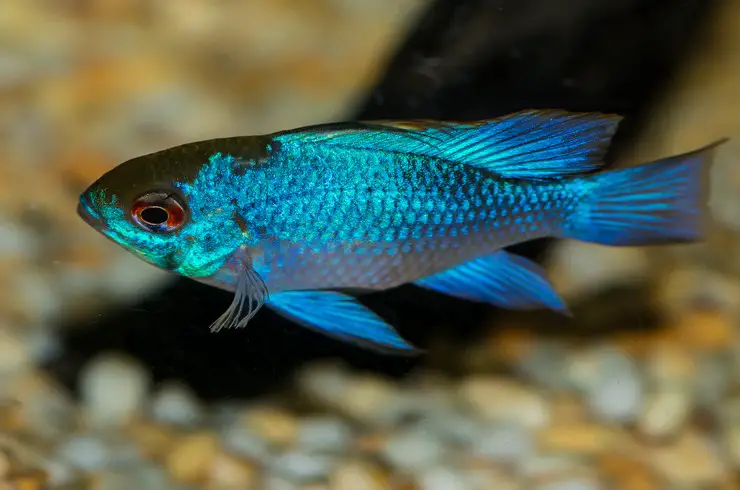
Unfortunately, the electric blue Apistogramma is not as hardy as its closest relatives, these fish require a more attentive approach to the content, so it is better not to recommend such a tenant to novice aquarists.
On the other hand, this Apistogramma inherited fascinating behavioral features and the ability to get along with other ornamental fish from ancestral forms.
Appearance
The electric blue Apistogramma, with the exception of color, is no different from its progenitor. Body moderately elongated and slightly laterally compressed. The head is pointed, with a small mouth and large eyes. Apistograms belong to dwarf cichlids, their size does not exceed 6-7 cm.
A characteristic feature is an elongated dorsal fin of 14-18 rays, the first of which is longer. The tail is triangular or rounded. Contrasting scales on the body are clearly visible.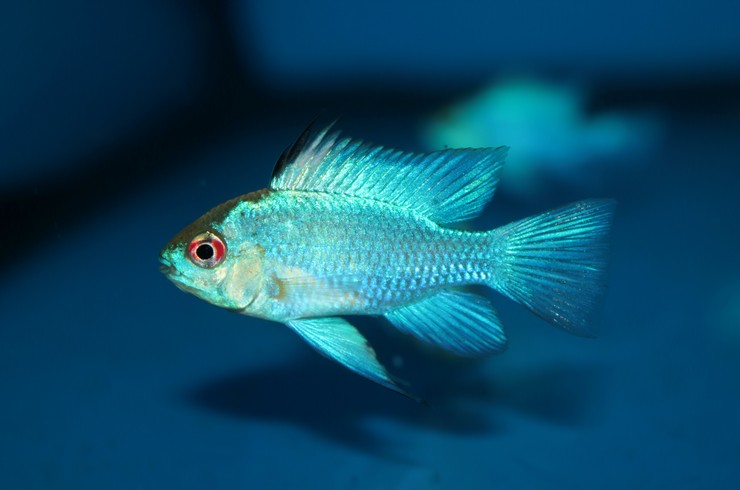
Most of the body of the electric blue Apistogramma is colored neon blue. There is a brownish-orange spot on the head. The eye has a bright red rim, from top to bottom it is crossed by a black stripe.
Males are larger than females, but the latter is in no way inferior in body color to males. The brightest color of fish is observed during the spawning period.
Habitat
Since the electric blue Apistogramma is an artificial form obtained as a result of the work of breeders, it does not occur in nature. However, from the ancestral form, she got a love for the soft and acidic water in which the Ramirezi Apistogramma lives.
Care and maintenance
To keep a couple of fish, you need a very small aquarium – 30 liters will be enough. It is best to design your aquarium in a natural style. It is recommended to use sand or small rounded pebbles as soil. Fish will look great surrounded by natural stones and driftwood. Planting plenty of live plants is important, they will improve the environment in the aquarium and serve as an excellent refuge for fish. The electric blue apistograms are not at all interested in plants, so you can plant any species you like.
It is possible to keep the fish both in pairs and in small harems when there are 2-3 females for one male. Apistograms prefer to swim in almost all layers of water.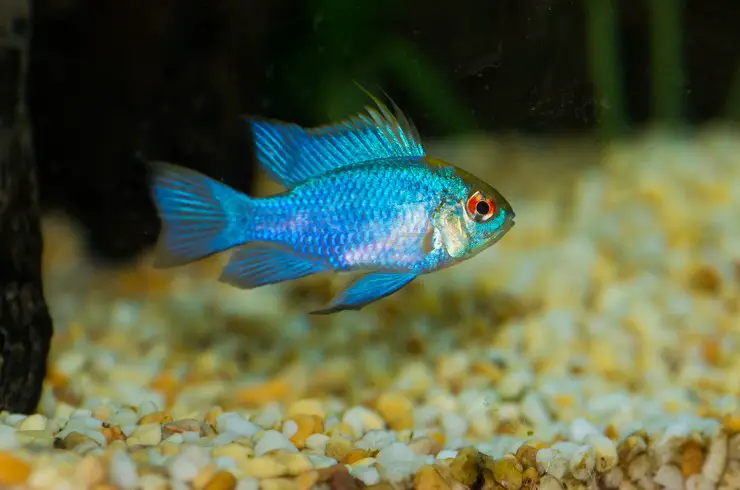
For the comfortable existence of the electric blue Apistogramma, it is important to provide good filtration and aeration in the aquarium. Fish are very sensitive to the presence of nitrogenous compounds in the water, therefore, water changes of up to 20% are required once a week. Tap water is not suitable for keeping fish, as it can contain a number of compounds hazardous to aquatic life (for example, chlorine and heavy metals). The addition of Tetra AquaSafe conditioner to freshwater instantly makes it fit for fish life.
Compatibility
Apistogramma electric blue is a calm and peaceful fish. She easily gets along even with small species. Good roommates will be neons, tetras, iris, platies, mollies, barbs, zebrafish, gourami, etc. Apistograms also live with scalars and even thermophilic discus.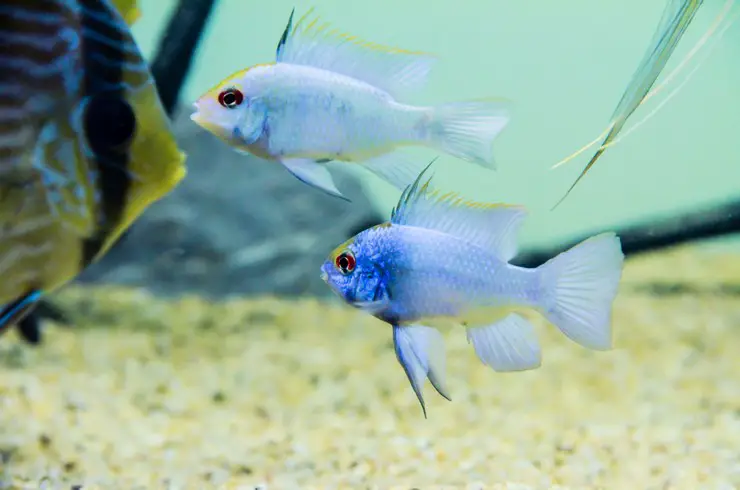
It is impossible to settle these dwarf cichlids with large and aggressive species, unfortunately, they will not be able to fend for themselves. The joint habitation of the electric blue Apistogramma and small shrimps are also contraindicated. After all, this fish, although small, is a real predator, which means that invertebrates will be under threat.
It should be noted that the aggressiveness of the electric blue Apistogramma increases during the spawning period. The fish zealously guard their offspring and drive away any strangers, but it does not come to serious injuries.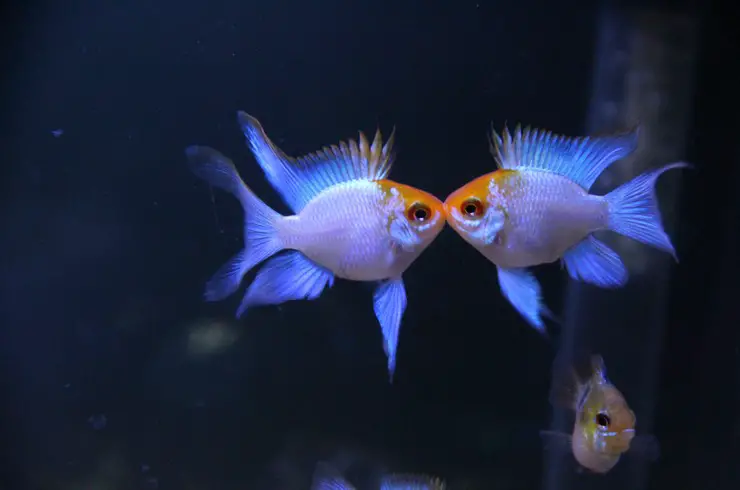
Feeding Apistogram Electrician Blue
Proper feeding of apistograms greatly affects the health, well-being, and longevity of fish. The electric blue Apistogramma, like its progenitor, is a predator. Therefore, it is important that the feed contains a lot of protein.
It is best to feed this fish with high-quality dry food.
When choosing the size of food, one must not forget that the mouth of the apistograms is small. Best suited for feeding:
- Tetra Cichlid Mini Granules are mini-granules for all types of dwarf cichlids. Fully meet the needs of apistograms for high-quality proteins. The size and shape of the granules are optimal for small mouths;
- TetraPRO Energy Multi-Crisps are high-energy chips with increased nutritional value and high vitamin content, thanks to the production of gentle low-temperature technology. Contains prebiotics for good digestion;
- TetraMin is a universal flake for all types of ornamental fish. The composition includes more than 40 components. Provide complete daily nutrition for fish;
- Fish will also appreciate the special delicacy in the form of popular food organisms in the special nutritional jelly Tetra FreshDelica. You can choose from bloodworms, brine shrimp, daphnia, or krill.
The electric blue Apistogramma is prone to overeating, therefore it is better to feed them twice a day with a small portion of food.
Reproduction and breeding
The process of breeding an electric blue Apistogramma at home is not particularly difficult and is similar to any other Apistogramma. For the most part, everything happens on its own, you should only slightly stimulate the producers and then feed the offspring.
Unfortunately, fish pairs do not always add up. And even if a couple is formed, there is no guarantee that the parents will look after their offspring. However, if everything works out, then the pairs of the electric blue Apistogramma persist for a long time.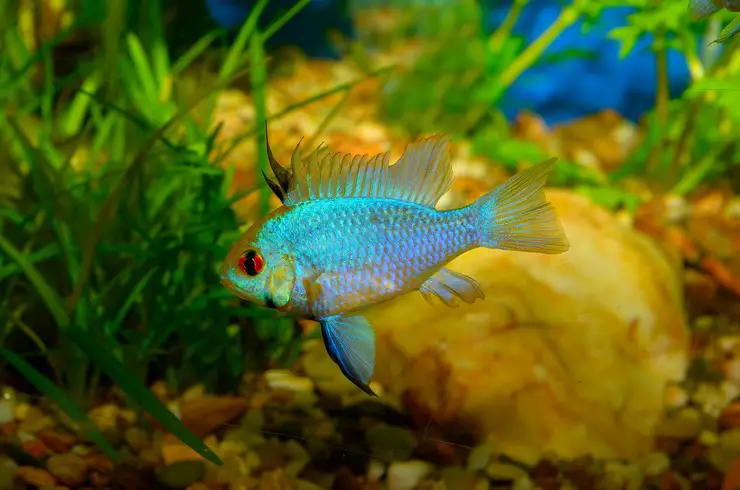
The electric blue Apistogramma reaches puberty at the age of 6-8 months, and its size is about 3 cm. If the cichlids are kept in a common aquarium, it is better to spawn in a separate container. Its volume should be about 15 liters, the water level is 10-15 cm. A slight flow of water should be provided using a low-power filter or compressor. Coarse sand and a couple of flat stones are laid at the bottom, several broad-leaved plants are planted. The female lays eggs on a stone or plant leaves.
In a spawning aquarium, certain parameters should be maintained so that there are no breeding problems. The water should be softer and warmer than the main aquarium. Frequent soft water changes are recommended to stimulate spawning.
The number of eggs can vary from 50 to several hundred. Both parents take care of the caviar. Incubation lasts 2-4 days, depending on the water temperature, after which the larvae appear, which feed on the yolk sac for another 5-7 days, and then proceed to an independent search for food.
Growth in Apistogramma fry is slow. Coloring occurs gradually. By the end of the first month of life, the fish become owners of a gray color, after a month they acquire a blue color, which becomes brighter over time.

